Types of toilets by technical specifications and design
The presence of properly functioning plumbing is one of the main factors for comfortable living in a city apartment and a comfortable cottage. The right choice of plumbing fixtures is the key to the convenience of using this equipment of modern everyday life. Do you agree?
The article presented to your attention describes in detail all the existing types of toilets. They differ in the location of the outlet pipe into the sewer and the installation method closely related to it. In order to make a purchase consciously and without errors, we have given the technical and design features of an important device in everyday life.
The content of the article:
Classification of modern toilets
It is difficult to imagine a modern bathroom without a toilet. This is an indispensable item in an apartment or house toilet. Using a night pot today is impractical unless it has lost its relevance for serving young children.
The considered plumbing fixture (toilet) must necessarily be present in an apartment and a private house.
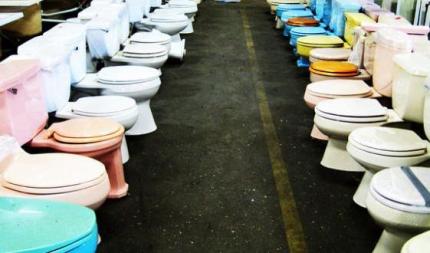
By standards, the height of an ordinary toilet bowl is 400–405 mm, and that of a child’s toilet is 335 mm. Most models are designed for a static load of 200 kg, but some manufacturers produce and can withstand up to 600 kg of product weight. The drain tank according to the norms will intervene 6 or 4 liters of water. These are standard specifications for all toilet models.
Types # 1: according to the material of manufacture
In the vast majority of cases, toilet bowls and water tanks in the kit are selected from one material. An exception is separate models with installation. They have a drain tank placed in a niche in the wall and are often made of plastic or metal, and the bowl installed next to it is made, as a rule, of sanitary ware.
Different manufacturers for the production of toilets use:
- Earthenware - the most popular and cheapest products, classic in domestic apartments.
- Porcelain is an expensive, but durable and sophisticated option.
- Metal is more a model for toilets in public buildings.
- Plastic - for now, exotic made from fiberglass and acrylic.
- Stone - if you take it, it’s from an artificial version, which is cheaper and stronger than natural.
The seat (chair) and cover are made mainly of plastic. But designer models can be equipped with wooden counterparts coated with waterproof varnish. Other materials are not used here due to reasons of hygiene and comfort.

With the exception of metal products, all toilet options from other materials do not tolerate shock loads. When a heavy object falls on them, they simply crack.
The most common types in everyday life are earthenware and porcelain plumbing fixtures. Faience is cheap, but it is porous and has a high level of water absorption of 10-12%. To avoid damage from moisture, I cover it with glaze.
Only she is able to protect the base material of the bowl. If the decorative glazed layer is damaged, then the faience toilet should be changed immediately. It is impossible to operate it further.
Species # 2: in the shape of a bowl
Manufacturers have no restrictions on the shape of the bowl. They are guided solely by design issues and customer preferences. However, there are some common sizes and layouts.
There are three main types of toilet bowl shapes:
- Peaks.
- Dish-shaped.
- Funnel-shaped.
Peak toilets are characterized by a forward-flushed discharge from the tank and an even or slightly concave rear wall inside the bowl. Excrement crawls along it into the water without forming a spray.
On such a bowl often there are traces of feces and the corresponding smell. And even the descent of water does not always allow you to completely get rid of such residues, you will often have to use a brush.
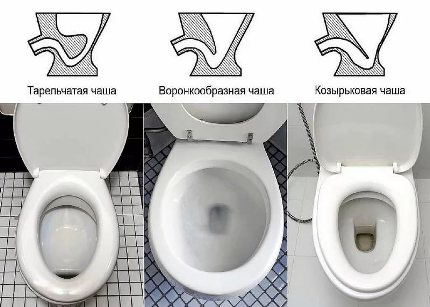
The plum variety drain is also offset forward. However, the back wall of this type of toilet is made in the form of a horizontal shelf (plate, protrusion). Waste of life activity first falls on it, and then only is washed off when water is supplied to the drain and further to the sewer. The result is dirty stains and odors.
With the means and methods of dealing with sediment on the surface of the toilet will introduce next articlecompletely devoted to this important issue.
Another drawback of this design is the constant presence on the shelf of small volumes of water. And this inevitably leads to the accumulation of salt deposits on the ledge, which is always problematic to get rid of. If the water from the pipes flows dirty and hard in composition, then a yellowish pattern of salts will quickly appear on the walls of the toilet bowl.
In the funnel-shaped version, the drain hole is located almost in the middle of the bowl. The odors and traces when using such a toilet are the least formed, the waste immediately falls into the water in the funnel. But this plus is greatly leveled by the frequent splashes when visiting the toilet "for the most part."
Types # 3: on the drain tank
According to the layout “tank + bowl”, combined and separate (low and high) structures are distinguished. The first type of toilet is made in the form of monoblocks and bolted elements. The tank in them is part of the design, because molded together in a single body.
Separate options are toilets with a tank on the shelf of a toilet bowl or a container on the wall. The water is drained into them through an opening adjacent to the tank and bowl or through a drain pipe made of metal or plastic.
Due to the high location of the tank, the discharge rate in such structures is higher, which ensures a high-quality flush of sewage. But they also produce more noise when the shutter release lever is pressed than the combined counterparts.
The drain mechanism is launched after:
- jerking a hanging rope or chain;
- pressing the handle;
- pushing a button.
The device for collecting / releasing water in the tank consists of a float valve (shutoff valves), a plastic float and a lever system. As the tank is full, the float shut-off and drain valves rises, which leads to the overlap of the water supply. After the discharge to the bowl, the tank is empty, and the process of filling it starts again.

The system for supplying water to the tank is:
- bottom;
- side.
In the first case, the inlet pipe is connected to the toilet bowl from below, and in the second, to the right or left. At the lower connection, the float is connected directly to the vertical stem in the valve, and at the lateral, by means of a horizontal lever with a valve on the side wall of the tank.
The volume of the toilet tank is designed for 4 or 6 liters of water. It can be any form and design. Models are both standard rectangular and triangular - for installation in the corner.
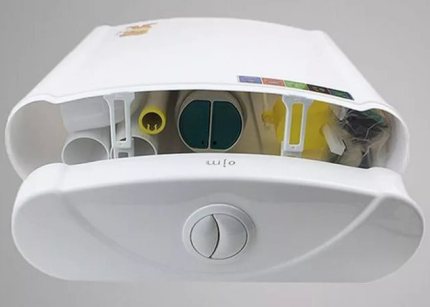
There are many mechanisms for draining water into the bowl, but the simplest and most common option is the “pear” in the form of a small rubber plunger. In the normal state, the weight of the liquid in the tank presses it against the drain hole. But when you press the button, it rises, and the water rushes by gravity into the bowl. And as the tank is filled, the liquid again presses it to the bottom, blocking the outlet.
Species # 4: flush type
Toilets differ in the type of drainage system inside the bowl.
There are three options for the movement of water in it:
- horizontal (cascading);
- circular swirl;
- circular line.
Horizontal discharge creates a powerful flow in the most contaminated area of the toilet bowl. However, in general, water washes with it a little more than half the area of the walls, because of this, it is often necessary to clean them with a brush.
This type of domestic toilet was mass produced in the Soviet Union. Now manufacturers have switched to the second and third options with the movement of water in a circle that are more suitable from the point of view of hygiene.
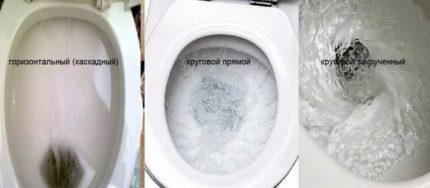
With a circular type of flushing, a groove with holes was made along the edge of the entire bowl. Water when discharged from the tank is distributed evenly and over the entire surface. This type of toilet is more rational use of water resources and quiet operation.
However, if the water in the pipeline is hard with a high salt content, then the holes in the gutter can become clogged. And then the number of jets will decrease, flushing will simply stop working.
Models with a circular type of drain are always more expensive than those with a horizontal one. Negligent manufacturers sometimes mimic an expensive option by installing a plastic insert into the rim in a classic cascade design.
However, such know-how in the work is not particularly different from direct flushing. And money is being asked for him as an advanced modification. With a circular drain, the toilet should be completely made of sanitary ware or stone.
Types # 5: for release into the sewer
Three types of toilet releases are distinguished:
- Horizontal.
- Squint.
- Vertical.
One of them has no particular advantages over the others. Here is more a question of the arrangement of the sewer system to which it is planned to connect the toilet. To use additional adapters to connect to sewer pipes is not too reasonable. The more joints, the greater the chance of leaks.
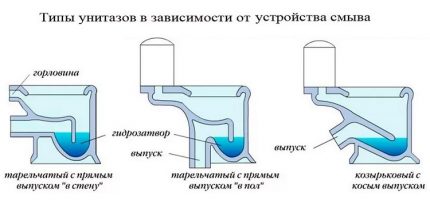
The oblique angle of the oblique outlet varies from 30 to 75 degrees. You can always choose a model that is optimally suited to the existing sewer system. If the release of the plumbing fixture and the outlet to the sewer do not match, use corrugation for the toilet, the specificity of which is set out in our recommended article.
If the pipelines in the toilet have not yet been laid, then the toilet must be selected for the planned wiring, so that it docked with the pipes then without any problems.
Ways to fix the toilets on the floor and walls
Choosing a toilet, one has to think not only about its technical parameters, but also about the design of the model. According to the method of attachment and installation location, all considered plumbing fixtures are either mounted or floor mounted. The appearance of the plumbing greatly depends on the type of installation.
It looks more aesthetically pleasing wall hung toilet. It is raised above the floor, which simplifies cleaning under it and in the toilet as a whole. True to install it is required installation - a support frame fixed on the wall of the toilet or on the floor.
Floor toilets are a classic for domestic houses. They are cheaper and easier to install. For them, there is no need to fix the installation on the wall. Fastening is carried out directly to the floor using dowels-screws.
In both types of structures, the tank can be located behind the false wall in the installation. This option looks better, but significantly complicates the repair. Moreover, even for the banal adjustment of the reinforcement, it is necessary to disassemble the masking structure, therefore it is better to build plumbing hatch.
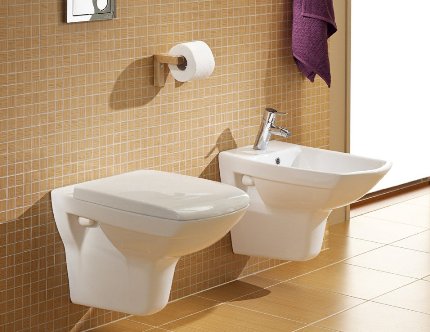
Additional functionality of sanitary equipment
Technologies are developing by leaps and bounds, innovations have reached such an ordinary plumbing fixture as a toilet. On sale can be found smart models with non-contact start-up of water, as well as with backlight and heated toilet seat. How much such innovations are needed is up to the owner of the house to decide.
One of the most popular additions to the toilet, allowing you to refuse to buy an expensive electronic device, is a pad or bidet cover in the form of a structurally changed cap or nozzle with nozzles. It is installed on a conventional toilet bowl as a companion device.
Such bidets allow for hygienic washing and exclude the use of toilet paper. They are easy to install and easy to manage.
After pressing the button, the nozzle with nozzles extends into the bowl and begins to spray the jets.And after the end of the procedures, this tip is removed back, previously cleaned of dirt in automatic mode.
In addition to the above optional accessories, the toilet can also be equipped with:
- a hygienic shower in the form of a watering can on the hose;
- self-cleaning system;
- a unit for smooth lowering of the cover;
- serving detergents and perfumes in a bowl;
- air drying;
- musical equipment;
- air fresheners and aerators.
All these additions increase the price of the toilet, but make visiting the toilet more comfortable.
Conclusions and useful video on the topic
The videos offered for acquaintance will simplify the study of the existing model range of toilets in order to understand exactly how one of their types differs from another.
Video # 1. Visual demonstration of varieties of an important plumbing fixture:
Video # 2. All about the flushing system in the toilet bowl:
Video # 3. Recommendations of a professional plumber for choosing a toilet:
Choosing a toilet, you have to start from the dimensions of the bathroom. Installing a large bowl in a small toilet does not work out by definition; you cannot forget about convenience. A circular drainage system is more practical, but you can buy a model with it only if the water in the pipes is soft and without salts - otherwise the holes in the gutter will quickly clog.
The visor bowl eliminates the formation of splashes, but forces the brush to be used more often. The dish-shaped option is the most losing. However, much in this choice depends on the purely personal preferences of the owner of the toilet.
Please write comments in the block below. Tell us which toilet option you prefer and why. Ask questions, share information that may be useful to site visitors, publish photos on the topic of the article.

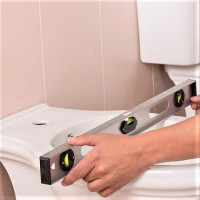 Standard toilet sizes: typical sizes and weights of different types of toilets
Standard toilet sizes: typical sizes and weights of different types of toilets 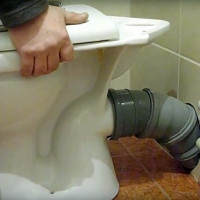 How to connect a toilet to the sewer: an overview of installation technologies for all types of toilets
How to connect a toilet to the sewer: an overview of installation technologies for all types of toilets 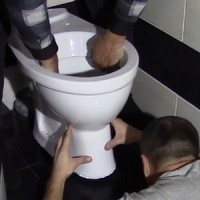 Do-it-yourself toilet installation: features of mounting toilet bowls of various designs
Do-it-yourself toilet installation: features of mounting toilet bowls of various designs 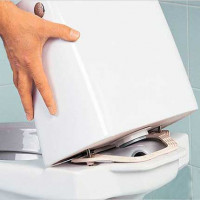 Laying between the tank and the toilet: types, purpose, installation features
Laying between the tank and the toilet: types, purpose, installation features 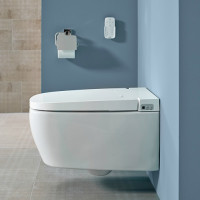 Electronic toilet: device, types + overview of the best models on the market
Electronic toilet: device, types + overview of the best models on the market 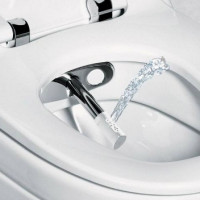 Lid for a bidet for a toilet: types, description of the principle of work and tips for choosing
Lid for a bidet for a toilet: types, description of the principle of work and tips for choosing  How much does it cost to connect gas to a private house: the price of organizing gas supply
How much does it cost to connect gas to a private house: the price of organizing gas supply  The best washing machines with dryer: model rating and customer tips
The best washing machines with dryer: model rating and customer tips  What is the color temperature of light and the nuances of choosing the temperature of the lamps to suit your needs
What is the color temperature of light and the nuances of choosing the temperature of the lamps to suit your needs  Replacement of a geyser in an apartment: replacement paperwork + basic norms and requirements
Replacement of a geyser in an apartment: replacement paperwork + basic norms and requirements
We installed a hanging toilet in the apartment and are very satisfied! It looks more compact, but at the same time rather big and quite convenient. So far, not a single minus has been noticed behind him. Yes, and cleaning the bathroom this option is much easier. Well, and, of course, I highly recommend not stinting on the bidet, now I can’t imagine life without it, but before I doubted its necessity.
Not in the description of one of the main pairs of meters of the toilet - the height of the water seal. The only way to deal with the problem of disruption of the water seal is to ensure its height is not less than 65-70 mm. European toilets cannot provide a satisfactory flush quality. Therefore, manufacturers, in order to “squeeze” the toilet bowl to the consumer, reduce the height of the water seal. Sometimes up to 30 mm.
Unhappy buyers installing similar toilets in multi-storey buildings serviced by FSWs (they themselves understand what kind of service they are), especially in old houses, then they suffer from a breakdown in the water lock, suffer from a stench, etc. etc. Stop selling the pig in a poke! 🙁 GIVE INFORMATION ABOUT HYDRAULIC SHUTTER HEIGHT!
Disruption of the toilet trap is a very rare occurrence. And if the fan riser is in order - not clogged, not deformed, not structurally changed, then despite the height of the water seal on your toilet there will be no breakdowns.
The height of the water seal affects its “stall” to a much lesser extent than the absence or clogging of a fan pipe, which eliminates the formation of vacuum in the sewer pipes that discharge from the toilet (as well as other plumbing devices). When a large volume of wastewater moves, a kind of “water piston” forms, which overlaps the entire cross section of the pipeline and in the final phase, as you move away from the plumbing fixture, simply “sucks” water from the hydraulic seal.
But if you are absent for a long time (or very rarely use the appliance), then the water from the water trap can simply evaporate and a strong “aroma” is provided to you. In this case, an oil film on the surface of the water can greatly help. In any case, the choice is yours and Google will help you!)
Until now, I had a Soviet toilet. And the devil pulled me to install a new one. I gave the locksmith 7000 r. for the toilet and work, and shortly before that I changed the tank and also paid 3000 r. Yesterday an Uzbek plumber installed a new toilet for me, and I realized that I could not use it. The Soviet seat was wider, this narrow.
Inside the toilet, the surface was flat and, excuse me, it was clear how much came out of me (I need to know this), a stream of water washed away everything instantly. In the new toilet, it’s not a flat surface, but sloping, and everything slides down into the water like a sled from a hill. Water does not wash off at a time, as it was in the old. Here the water mixes with ... and gurgles, like soup in a saucepan.
Water does not wash away even thin as chiffon toilet paper. It takes me 10 times more water than an old toilet. But from the fifth time, a piece of paper dangles from above.
How can I find the one I had? Do they release such? Where am I going to get this now? 10 thousand down the drain. If you know if there are now Soviet-style toilets, please inform. What is it called? Can you tell me where you can buy one?
Hello. It's not about the Soviet-modern. The fact is that you have a small selection in the store. You are interested in a toilet with a so-called “shelf”; on sale this is called “anti-splash”. And since we are so frank, I note that the shelf was not designed to count ... hmm ... feces. It is in order to reduce the amount of spray when flushing, as well as to prevent splashing, falling ... hmm ... feces.
By the way, you can choose a toilet with an anti-splash on the Internet that is right for you. The width of the shelf and the angle of its inclination can be different. However, like the seat. Choose the right model without leaving your home and ask the plumbing store to bring you such an order. Or go to a large store and there will be more choice of toilets. The main thing is to describe to the seller what exactly you need. Pay attention to: the angle of the shelf, its width, the width of the rim of the seat, the diameter of the seat, the capacity of the tank and the type of flush. Write down all these parameters and with them to the store.
I repeat - the shelf is called the anti-splash function! 🙂 Good luck!